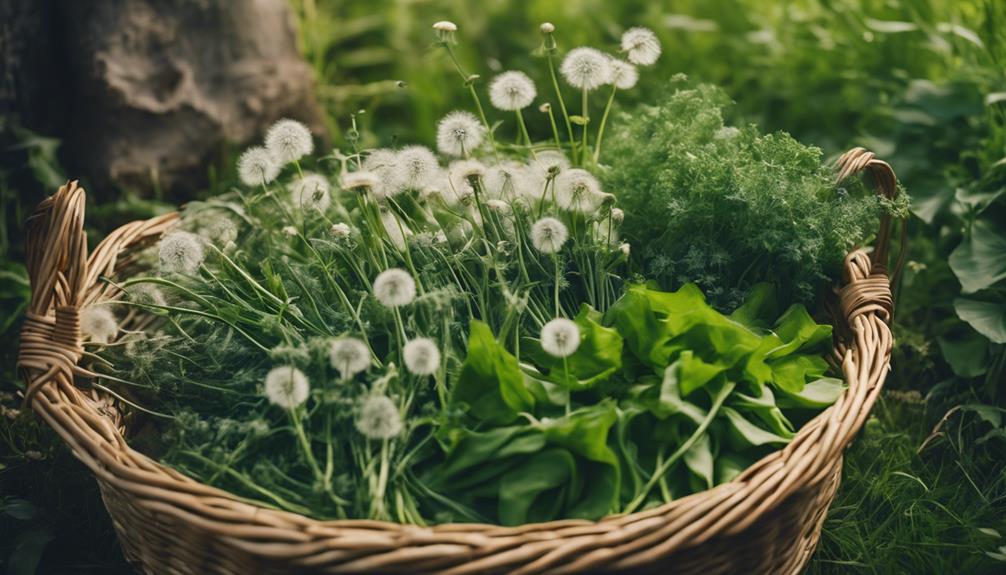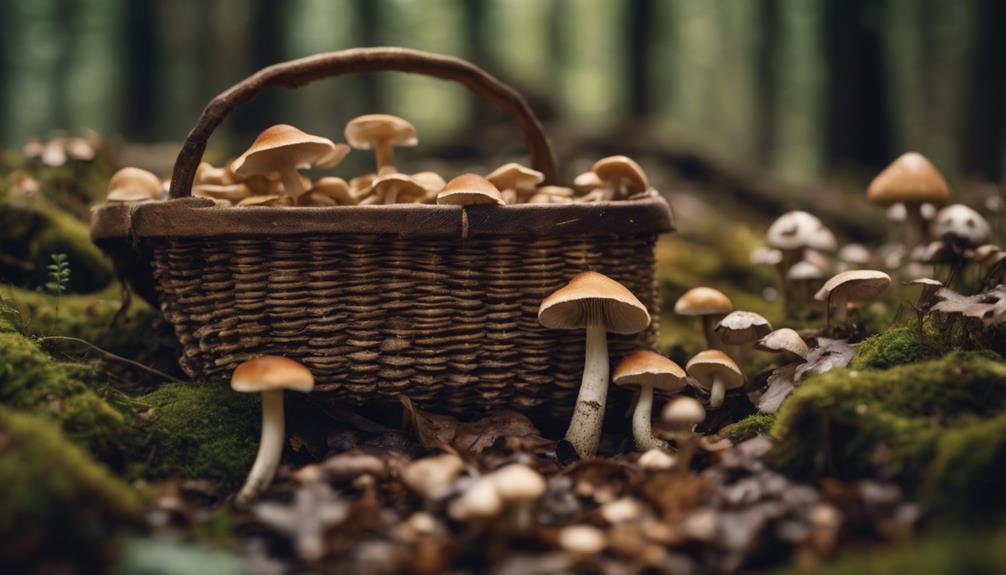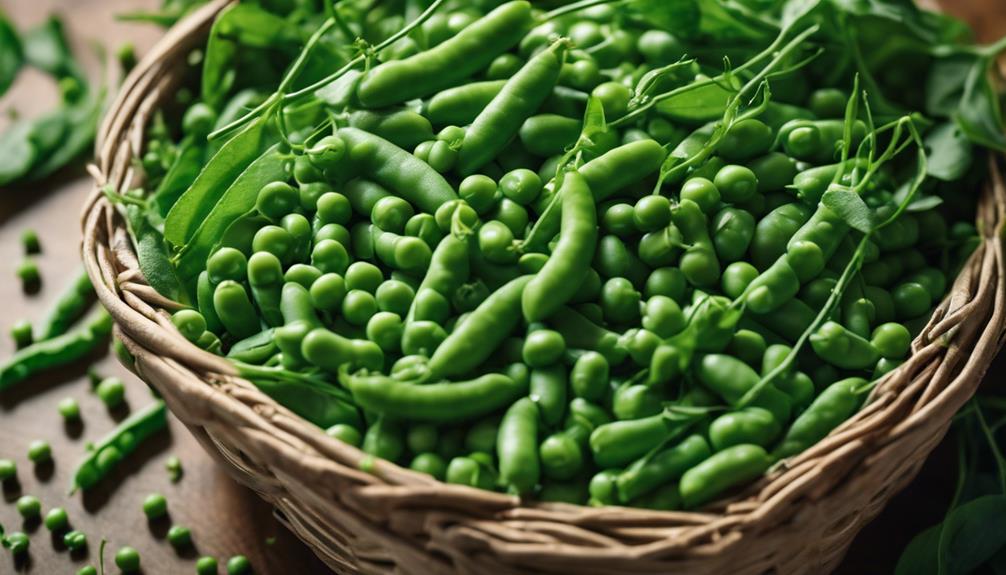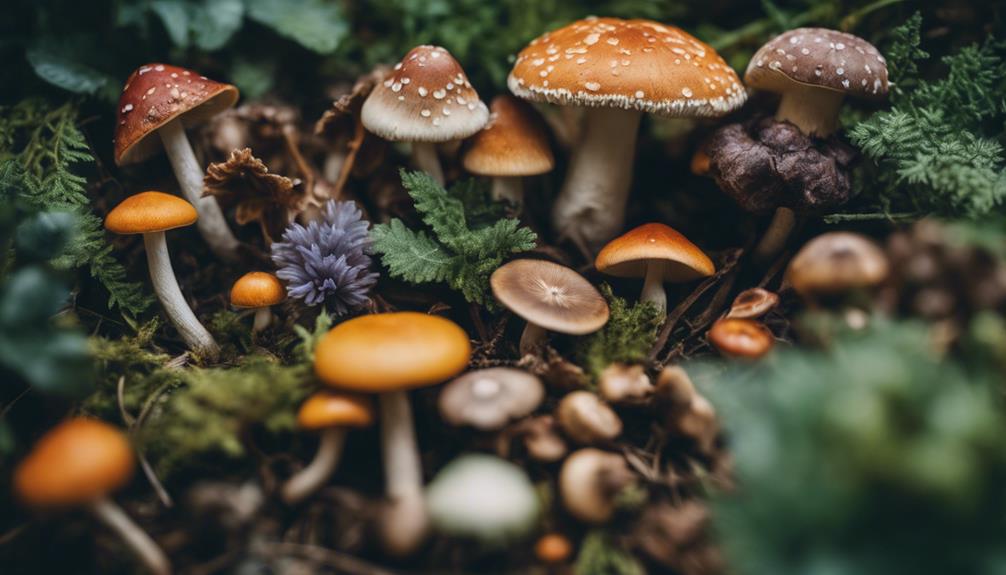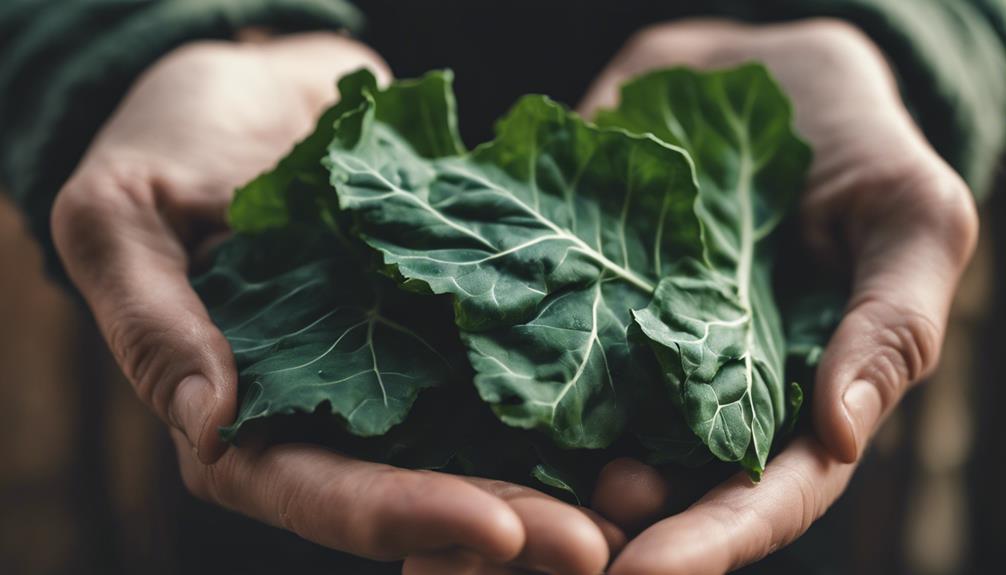You're likely surrounded by a culinary treasure trove in your own backyard. Common weeds like dandelions, plantains, and wild garlic are packed with nutrients and offer culinary delights. Foraging promotes sustainable living, connection with nature, and can be a vital alternative to store-bought produce. However, it's important to research and identify edible plants, distinguishing them from toxic ones. Start with familiar plants, learn about their nutrients, and experiment with unique recipes. As you explore your backyard, you'll uncover diverse flavors and nutritional benefits, and discover the joys of foraging – and there's even more to uncover.
Key Takeaways
- Familiarize yourself with common edible weeds like dandelions, plantains, and wild garlic that can be found in your backyard.
- Learn to identify these wild edibles correctly to ensure safe consumption and avoid confusing them with toxic lookalikes.
- Start foraging with familiar plants and explore your backyard, local parks, and green spaces for a variety of wild foods.
- Be aware of safety considerations, such as pollution and contaminants, when foraging in urban areas and take necessary precautions.
- Get creative with your finds and experiment with unique recipes to turn your backyard weeds into gourmet delights.
Foraging Basics and Benefits
As you step into the world of foraging, start by getting familiar with the common weeds that might be growing in your own backyard, like dandelions, plantains, and purslane, which aren't only easy to identify but also packed with nutrients.
These wild, edible plants are just waiting to be discovered and enjoyed. Foraging isn't just about finding free food; it's also about connecting with nature and promoting sustainable living.
By venturing into your backyard, you'll uncover the benefits of foraging, from discovering new flavors to reaping the nutritional rewards of wild plants. As you explore, you'll learn to distinguish edible plants from toxic ones, ensuring a safe and enjoyable foraging experience.
The benefits of foraging extend beyond your plate, too. By embracing this adventure, you'll enhance your connection with nature and contribute to a more sustainable lifestyle.
Common Edible Weeds to Find

As you explore your backyard, you'll likely stumble upon an array of edible weeds waiting to be discovered. From the pungent flavor of wild garlic to the delicate taste of dandelion greens, these common weeds offer a world of culinary possibilities.
Let's take a closer look at some of the most common edible weeds you can find, and how to incorporate them into your cooking.
Wild Garlic Abounds
You'll likely stumble upon clusters of wild garlic in sunny areas with well-drained soil, often near garden beds or along pathways in your own backyard. This common edible weed, also known as Allium vineale, is a treasure trove of culinary delights.
Wild garlic has thin, hollow leaves that resemble chives and produce small bulbs underground, making it an ideal find for foraging enthusiasts. You can harvest the leaves, bulbs, or flowers of wild garlic to incorporate into salads, pesto, soups, or as a garnish for various dishes, adding a mild garlic flavor to your creations.
When foraging for wild garlic, look for areas with plenty of sunlight and well-drained soil, as this weed thrives in these conditions. With its subtle flavor and versatility, wild garlic is a great addition to many recipes, making it a great find in your backyard.
Dandelion Delights Found
In your backyard, you're likely to find dandelions thriving in lawns, meadows, and even in the cracks of sidewalks, their bright yellow flowers and toothed leaves making them hard to miss. As a common edible weed, dandelions offer a rich source of vitamins A, C, and K, as well as minerals like iron and calcium. The entire plant is edible, and you can use it in various ways.
| Part of the Plant | Usage |
|---|---|
| Roots | Dried and roasted as a coffee substitute |
| Leaves | Used in salads or cooked as greens |
| Flowers | Made into infused syrups, jellies, or battered and fried into tempura |
Nettle Rich Harvest
Nettles thrive in moist areas, popping up along streams, rivers, and even in your own backyard, offering a rich harvest of edible leaves, stems, and roots. As you forage in your backyard, you'll find that nettles are a nutritional powerhouse, packed with vitamins A, C, and K, as well as iron and calcium.
The stinging hairs on the leaves might be a concern, but don't worry – a quick heat treatment neutralizes them, making them safe to handle. You'll discover two main types of nettles: Stinging nettle and Wood nettle, both offering culinary and medicinal benefits.
The best part? Nettles are prolific, and you can harvest them without harming the plant, providing a versatile ingredient for cooking, drying, or brewing tea. When you incorporate nettles into your cooking, you'll enjoy a unique flavor profile and reap the health benefits that come with foraging wild foods in your own backyard.
Culinary Creations From Wild Foods

Discovering your backyard's often-maligned weeds and turning them into gourmet delights can be an exciting culinary adventure. You can reveal the hidden flavors and health benefits of wild foods growing in your own backyard. By experimenting with unique recipes, you'll uncover the diverse flavors and nutritional benefits of wild foods.
Try whipping up dandelion fritters, violet jelly, or nettle soup using your freshly foraged backyard goodies.
You can also create homemade herbal teas, infused oils, and wildflower desserts from the plants you've gathered. Infuse your cooking with the fresh, nutrient-rich flavors of wild foods found close to home.
Backyard foraging allows you to access the rich flavors and health benefits of wild foods, which are often more nutritious than their store-bought counterparts. By embracing culinary creations from wild foods, you'll open up a world of flavors and possibilities in your own backyard.
Safety Tips and Best Practices

Before you start foraging, make sure you've done your homework and can confidently identify the plants you're about to eat. Foraging in your backyard can be a fun and rewarding experience, but it's important to prioritize safety above all else.
Here are some essential safety tips and best practices to keep in mind:
- Research, research, research: Always research and identify common edible plants like dandelions, plantains, and yarrow before foraging in your backyard.
- Be cautious of lookalikes: Take precautionary measures to distinguish edible plants from toxic ones to guarantee safe foraging practices.
- Start with the familiar: Explore the treasure trove of edible and medicinal plants in your own garden by starting with familiar plants.
- Learn about nutrients and benefits: Learn about the nutrients and benefits of foraged plants to make informed choices while foraging in your backyard.
- Utilize local resources: Utilize local resources and guides to enhance your knowledge and safely identify edible plants close to home.
Wild Edibles for Medicinal Use

As you venture into your backyard, you'll discover a treasure trove of wild edibles that not only add flavor to your meals but also offer medicinal benefits. Many common backyard weeds have been used for centuries for their medicinal uses.
For instance, dandelions, plantains, and violets are rich in anti-inflammatory and antioxidant properties. Chickweed and yarrow, on the other hand, are known for their healing and immune-boosting benefits. Purslane, henbit, and self-heal are other common edible weeds that can be used to treat cuts, colds, and digestive issues.
Purple dead nettle and clover are also rich in anti-inflammatory and immune-boosting properties. Additionally, mallow and pineapple weed, often found in yards, offer medicinal uses for inflammation, relaxation, and digestive support.
Foraging in Urban and Suburban Areas

As you explore foraging in urban and suburban areas, you'll discover hidden gems in your neighborhood.
You'll learn to identify common urban weeds, uncover overlooked edible landscapes, and pinpoint neighborhood foraging hotspots.
Urban Weed Identification
When venturing into urban foraging, you'll be surprised to discover the abundance of edible weeds growing in your backyard, waiting to be identified and utilized. Urban foraging is all about recognizing the potential of the plants growing around you, and with a little knowledge, you can reveal a world of culinary and medicinal possibilities.
To get started, it's crucial to understand your local environment and the safety practices that come with foraging in urban areas. Here are some key considerations to keep in mind:
- Assess the soil quality and avoid areas that may be contaminated with heavy metals or other pollutants.
- Research the history of the plants you're interested in foraging to make sure they haven't been sprayed with pesticides or herbicides.
- Familiarize yourself with the most common edible weeds found in your region and learn how to identify them correctly.
- Know what parts of the plant are safe to consume and how to prepare them for eating.
- Consult with local experts or join a foraging group to gain knowledge and guidance on urban foraging in your area.
Overlooked Edible Landscapes
You've likely overlooked the edible landscapes hiding in plain sight in your own backyard, neighborhood parks, or even along sidewalks and streets. Urban and suburban areas offer a diverse range of wild foods, and you might be surprised at what you can find.
Common edible plants like dandelions, plantains, and violets can be found growing in your backyard or local parks, just waiting to be discovered. Urban foraging can be a fun and rewarding experience, but it's essential to keep safety considerations in mind. Be aware of pollution and contaminants that may affect the quality of the plants you forage.
When exploring your local environment, you'll likely stumble upon a treasure trove of delicious and nutritious wild foods. Backyard foraging is an excellent way to connect with nature and reduce your reliance on supermarkets. By becoming more mindful of the edible plants growing around you, you can start enjoying the benefits of urban foraging.
Neighborhood Foraging Hotspots
Many urban and suburban neighborhoods harbor hidden hotspots for foraging, with backyards, parks, and green spaces offering a surprising array of wild edibles waiting to be discovered. As you explore your neighborhood, you'll be surprised at the variety of edible wild foods that grow right under your nose.
When you start looking, you'll find that:
- Your backyard might be home to dandelions, plantains, violets, and chickweed, all common edible wild plants.
- Local parks and green spaces can provide a treasure trove of wild edibles, if you know what to look for.
- Urban foraging requires some precautions, like avoiding areas with pesticides or pollutants, to make sure your finds are safe to eat.
- Neighborhood walks can be a great way to discover new wild edibles and get some exercise at the same time.
- With a little knowledge and caution, you can start foraging in your own backyard and enjoy the delicious and nutritious rewards of urban foraging.
Remember to always prioritize safety and sustainability when foraging, and happy foraging!
Getting Kids Involved in Foraging

Turn foraging into a fun outdoor adventure for kids by transforming it into a scavenger hunt for edible plants right in your own backyard. Engage your kids in foraging by teaching them to identify common backyard edibles like dandelions, clover, and violets. This hands-on learning experience will spark their interest in wild foods.
Under your supervision, encourage kids to safely pick and taste test their backyard finds, exploring the culinary possibilities of foraging with kids. Create simple recipes together using foraged ingredients, and watch their excitement grow as they discover the flavors and textures of wild foods.
By exploring the backyard ecosystem and its edible treasures, you'll instill a sense of wonder and appreciation for nature in your children. As you forage together, you'll not only find delicious wild foods but also create lasting memories with your kids.
Saving Money With Wild Edibles

Your grocery bills can take a significant hit when you start foraging for wild edibles in your backyard, providing a cost-effective alternative to store-bought produce. By incorporating backyard foraging into your daily routine, you can enjoy delicious and nutritious wild foods while saving money.
Here are just a few benefits of saving money with wild edibles:
- Discover free, nutritious wild foods in your backyard, reducing reliance on store-bought produce.
- Create budget-friendly and sustainable meals using edible plants like dandelions, plantains, and violets.
- Enjoy a deeper connection with nature while utilizing backyard foraging to reduce your grocery bills.
- Learn to identify and harvest backyard wild foods to create cost-effective meals.
- Reduce your reliance on store-bought produce and save money in the long run.
Exploring Seasonal Wild Foods

As you start to reap the financial benefits of foraging, it's time to explore the seasonal wild foods that your backyard has to offer. Exploring seasonal wild foods is essential to maximize your foraging experience.
In the spring, you'll find a variety of edible plants like wild garlic, nettles, and dandelion greens. These spring wild edibles are packed with nutrients and can be used in a variety of dishes. Foraging in April in the UK offers the perfect opportunity to gather these fresh, seasonal ingredients straight from nature. Wild garlic, with its distinctive flavor, is excellent in pestos and soups, while nettles can be blanched and used in teas or as a spinach substitute. It’s essential to harvest responsibly, ensuring you leave enough for wildlife and future growth.
Summer brings an abundance of berries, flowers, and herbs like yarrow and elderflower, perfect for adding flavor and medicinal properties to your meals.
In the fall, you'll discover nuts, seeds, and roots like acorns, burdock, and chicory, which can be used in soups, stews, and as a natural remedy.
Understanding the seasonal availability of wild foods helps you plan your foraging expeditions in your backyard. By knowing what's in season, you can forage for food that's fresh, nutritious, and free.
Frequently Asked Questions
What to Avoid When Foraging?
When foraging, you'll want to avoid polluted areas, toxic look-alikes, and plants with allergenic properties or chemical treatments, making sure to positively identify each plant to steer clear of harmful species and health risks.
What Are the Best Foraged Foods?
You'll love foraging for dandelion greens, like Sarah did in her backyard, yielding a delicious and nutritious salad with a tangy flavor, rich in vitamins A, C, and K, and antioxidants, perfect for a healthy and invigorating meal.
How to Forage in Your Backyard?
You start foraging in your backyard by identifying common edible plants, researching to distinguish between safe and toxic ones, and gradually familiarizing yourself with a few plants at a time to master foraging safely.
How to Forage for Beginners?
You're starting from scratch, so begin by researching common edible plants, learning to identify them safely, and practicing with a few easy-to-spot species like dandelions or plantains to build your foraging confidence.
Conclusion
As you set off on this wild adventure into the world of backyard foraging, the great outdoors unfolds like a treasure map, waiting to be deciphered.
Wild edibles hiding in plain sight transform into culinary treasures, medicinal wonders, and money-saving secrets.
With every discovery, the boundaries of your plate, pantry, and perspective expand.
Begin this wild adventure, and your relationship with nature – and your taste buds – will forever be reshaped.

